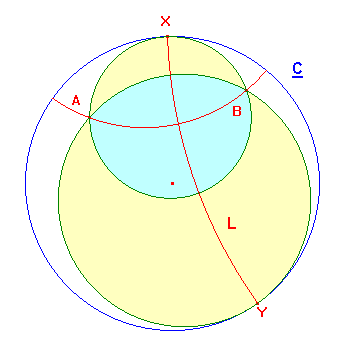|
the definitions
Suppose that Cε H+. Then there is a unique hyperbolic circle
through A,B and C. By the remark following the second version
of the second circumcircle theorem, there is a euclidean
(s(AB),s(AC),s(BC)) triangle. we draw such a triangle A*B*C*,
(a) |A*C*| = s(AC), |B*C*| = s(BC), and
(b) C*εR+
Clearly, this describes C* uniquely.
For CεH-, we define C*εR- similarly.
f(A,B) is the map taking C to C*.
To show that f(A,B) is a bijection, we produce the inverse map.
Suppose that DεR+. Take r,s such that |A*D| = sinh(½r), and
|B*D| = sinh(½s). We already have |A*B*| = s(AB), so we put
t = d(A,B), so that |A*B*| = sinh(½t).
Now, A*DB* is a euclidean triangle, so |A*D|+|DB*| > |A*B*| .
Thus sinh(½r)+sinh(½s) > sinh(½t).
sinh(x+y)=sinh(x)cosh(y)+sinh(y)+cosh(x)≥sinh(x)+sinh(y)
as cosh(z)≥1. it follows that r+s>t. The others are similar.
Finally, we see that there is a hyperbolic (r,s,t) triangle.
Hence there is a unique D* such that
(a) d(A,D*) = r, d(B,D*) = s (and d(A,B) = t), and
(b) D*εH+.
There is a similar definition for DεR-.
g(A,B) is the map taking D to D*.
We observe immediately that f(A,B) and g(A,B) are inverse functions,
so each is a bijection.
result 1
(1) f(A,B) maps the arcs of a hyperbolic circle through A and B to
the arcs of a euclidean circle through A* and B*.
(2) g(A,B) maps the arcs of a euclidean circle through A* and B* to
the arcs of a hyperbolic circle through A and B.
(3) In the correspondence, the minor and major arcs in the hyperbolic
sense correspond to the minor and major euclidean arcs.
proof
To avoid unnecessary repetition, we shall write
C* for the image under f(A,B) of CεH(A,B), and
L* for the image of an arc of a hyperbolic circle through A and B.
result 2
Let L be an arc of a hyperbolic circle through A and B.
If A,B,C,D lie in this order on L, then
A*,B*,C*,D* lie in this order on L* .
proof
Of course, an easy induction gives the
Corollary
Let L be an arc of a hyperbolic circle through A and B.
If A,B,C(1),...,C(r) lie in this order on L, then
A*,B*,C(1)*,...,C(r)* lie in this order on L* .
Consideration of the radii shows that we cannot in general assert
that f(A,B) acts uniformly on distances, i.e. that |X*Y*| = s(XY).
result 3
For C,DεH(A,B). Then C,D lie on a hyperbolic circle through A and B
if and only if C*,D* lie on a euclidean circle through A* and B*.
If either condition is satisfied, then |C*D*| = s(CD).
proof
This is really a disguised form of ptolemy's theorem, as the proof shows.
|
|
|
Combining these results, we have
result 4
Let n ≥ 3.
There exists a convex cyclic hyperbolic polygon with sides of lengths
t(1),...,t(n) in this order if and only if there is a convex cyclic euclidean
polygon
with sides of lengths s(t(1)),...,s(t(n)) in this order.
If the polygons exist, then they can be chosen so that circumcircles
have diameters h,e, where e=s(h).
We simply take a hyperbolic segemnt AB of length t(1) and apply the
results to get the equivalence of the existence conditions. The maps
f(A,B), g(A,B) can be used to get one polygon from another.
Only the result about the diameters of circumcircles needs comment.
Suppose we choose C,D on the hyperbolic circumcircle so that CD is
a diameter. Then d(C,D)=h. By result 3, |C*D*|=s(CD)=s(h). Also
from result 3, we see that |C*D*| is the maximal length between
points of the euclidean circle. Thus |C*D*|=e.
In the case n = 3, we know that the size of the circumcircle is unique.
This can also be shown for n = 4 using the metrical approach.
|
Recall s(t)= sinh(½t) |
